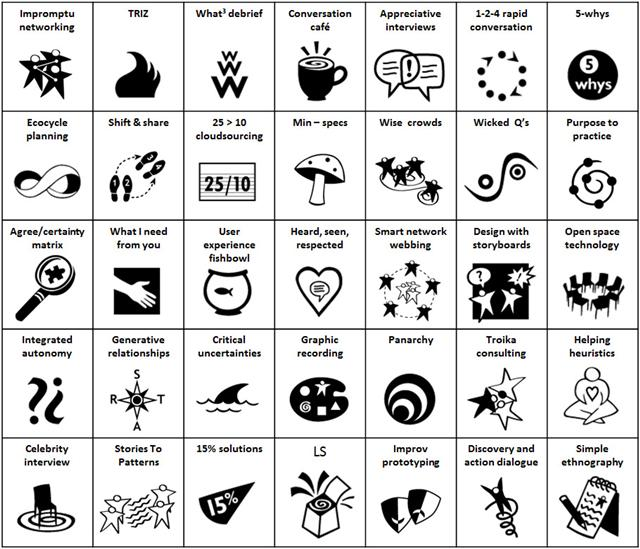
What are Liberating Structures?
How to start using Liberating Structures in your organisation or group
What are Liberating Structures?
Liberating Structures are a selection of 33 alternative structures for facilitating meetings and conversations, curated by Henri Lipmanowicz and Keith McCandless.
What’s the value in them?
There are five main conventional “microstructures” that we default to in organisations and groups:
- Presentations
- Managed discussions
- Status reports
- Open discussions
- Brainstorms
The problem with these is they are either too constraining (in the case of presentations, managed discussions and status reports) or too loose (in the case of open discussions and brainstorms).

Liberating Structures, on the other hand, are designed to embrace distributed control and include a fairer, larger number of people in shaping the next steps. The benefits? Innovation, inclusion, participation, clarity, purpose, fun… you’ll see when you experience them.
Do you have to be a facilitator to lead Liberating Structures?
Nope! Liberating Structures are deliberately simple and anyone can lead them which means they can spread virally in an organisation or group. Once you’ve experienced one, it’s very easy to start experimenting. All of the instructions of how to run Liberating Structures are on the website and in the book. On the website, select the LS Menu tab and pick one. If, like me, you’re lazy and like simplicity, read the purpose at the top and then skip to step 5: Sequence of Steps and Time Allocation.
Where do I start?!
I’d recommend starting with the book for context, but I will say that it’s not the easiest read. The website is useful but also not incredibly user-friendly. The best way to learn Liberating Structures is to experience them so if you can find a workshop or Meetup where you’re based, try that. An even better way to learn Liberating Structures is to practice! Just pick one and try it. Experiment! There’s now a handy, free mobile app (available for Apple and Android) that will help you decide which ones you might want to start with, giving you simple instructions on how to run them.
Which Liberating Structure do I start with?
It doesn’t really matter which Liberating Structure you use. Any of them will be more effective than a conventional microstructure. However, here are five Liberating Structures I used regularly to get you started.
- 1–2–4-All (12 mins)
You can integrate this into any meeting, conversation or workshop super easily. It’s a great way of easing people into participating or discussing something, especially if there are people in the group with a tendency to be quiet. The sequence is: reflect on something (a question, a topic, an idea) for 1 minute individually in silence, then discuss it in pairs for 2 minutes, then in fours for 4 minutes, and then come together as a whole group and cherry pick some highlights from each four to share with the whole group. - Impromptu Networking (20 mins)
This is a good one to kick off a session with a team or group, especially if people don’t know each other very well. Esssentially, it involves people getting into pairs and rapidy sharing one thing they want to give to the group, one thing they want to get from the group, and a question they bring with them. You do three rounds of this so it’s a good way to warm up, get to know people, and help people set an intention for their participation. - TRIZ (35 mins)
A fun, high-energy favourite of mine, this one is great for identifying things that are getting in the way for you to achieve your desired outcome as a group. It’s a great eye-opener for teams who have maybe become a bit complacent or stagnant and very cathartic for frustrated people. I ran it with a group of HR directors in the public sector once and the laughter and energy was incredible. They got some real insights about how they needed to take ownership of behaviour change if they had any hope of others in their organisations doing the same. - Wise Crowds (15 mins per person)
This one’s useful if you want to tap into the creativity and intelligence of a group to solve problems or generate ideas. It’s a simple role play, basically, with a client and the others acting as consultants. The rules of the game, however, mean that the consultants can’t butt in or dominate, and the client listens to the consultants discussing suggestions silently and with their back turned so as not to influence the conversation. It works especially well when you have a group of people with diverse knowledge and experience. - 25/10 Crowdsourcing (30 mins)
If you’re ever frustrated that your group or team generates loads of great ideas that never go anywhere, this could be for you. It’s a rapid way to vote on possible ideas to explore further. Once you’ve decided on a few ideas, you can use some other Liberating Structures to drill down into the detail in order to bring them to life.
I want to use Liberating Structures in a meeting or workshop. How do I chose which one to use?
Have a play around with the Liberating Structures matchmaker which helps you identify a purpose and matches it with a Liberating Structure. You can do this alone based on what you want to achieve, and put together what’s called a “string” of Liberating Structures. Or you can use the matchmaker in a group to cocreate the agenda. To do this, use 1–2–4-All to vote on which structures (maybe start with 4 or 5 to begin with) would help you serve your purpose. You don’t have to know all 33 Liberating Structures off by heart — I certainly don’t! I often use the matchmaker and have the book or website to hand to guide us through the ones we choose.
What are some tips?
- Say as little as possible. You can introduce most of the Liberating Structures just by sharing the purpose the authors have written. The less you talk, the more space you give for others to participate.
- Some of the suggested timings will feel fast but try to stick to them. If you need more time or to go deeper, do another round rather than dragging out a particular step. If you run over time, it’s easy to fall into the trap of a loose open discussion again.
- To keep time, especially in large groups, I usually use tingsha bells (or similar). In smaller groups, I use a timer on screen so people can see how much time they have left. This is a great one recommended by a participant in a workshop I ran in Sweden recently.
- When silent individual reflection is required, be firm in enforcing it — it’s important, especially for introverts!
- Sometimes it might be useful to put some key instructions on slides for the group. The fewer words the better, though!
- Be aware of space — is there room for people to stand if they need? Or sit in pairs? Consider what materials you might need like flip chart paper, pens and so on.
- Make them your own. You’ll learn over time which ones you like best and how you prefer to run them. Some people like to give all the instructions up front. Personally, I try to keep them to a minimum. For example, with TRIZ I prefer to give the instructions bit by bit because I feel it inhibits people’s creativity if they know what’s coming next.
If you have any questions or want to chat about Liberating Structures, you can contact me on Twitter or via my website (www.reimaginaire.com). I also run Liberating Structures workshops in London and Stockholm from time to time so keep an eye out for those!
